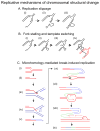Mechanisms of change in gene copy number
- PMID: 19597530
- PMCID: PMC2864001
- DOI: 10.1038/nrg2593
Mechanisms of change in gene copy number
Abstract
Deletions and duplications of chromosomal segments (copy number variants, CNVs) are a major source of variation between individual humans and are an underlying factor in human evolution and in many diseases, including mental illness, developmental disorders and cancer. CNVs form at a faster rate than other types of mutation, and seem to do so by similar mechanisms in bacteria, yeast and humans. Here we review current models of the mechanisms that cause copy number variation. Non-homologous end-joining mechanisms are well known, but recent models focus on perturbation of DNA replication and replication of non-contiguous DNA segments. For example, cellular stress might induce repair of broken replication forks to switch from high-fidelity homologous recombination to non-homologous repair, thus promoting copy number change.
Figures





References
Publication types
MeSH terms
Grants and funding
- R01 GM064022/GM/NIGMS NIH HHS/United States
- R01 GM80600/GM/NIGMS NIH HHS/United States
- R01 CA085777/CA/NCI NIH HHS/United States
- M01 RR000188/RR/NCRR NIH HHS/United States
- R21 NS059529/NS/NINDS NIH HHS/United States
- R01 NS59529/NS/NINDS NIH HHS/United States
- R01 CA85777/CA/NCI NIH HHS/United States
- R01 GM53158/GM/NIGMS NIH HHS/United States
- R01 GM080600/GM/NIGMS NIH HHS/United States
- R01 GM053158/GM/NIGMS NIH HHS/United States
- R01 GM64022/GM/NIGMS NIH HHS/United States
- R01 NS058529/NS/NINDS NIH HHS/United States
LinkOut - more resources
Full Text Sources
Other Literature Sources
Molecular Biology Databases

